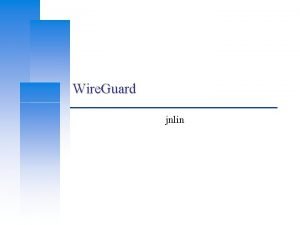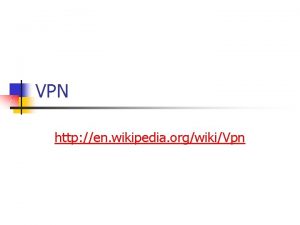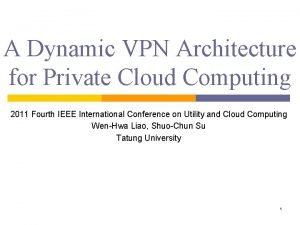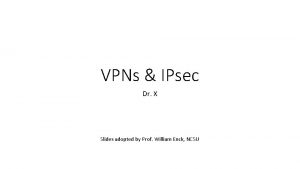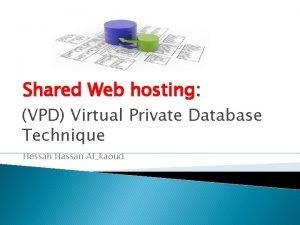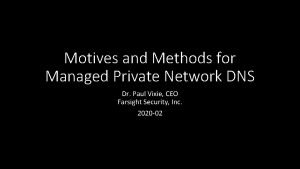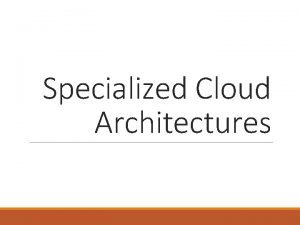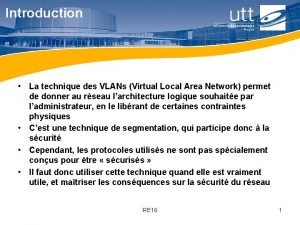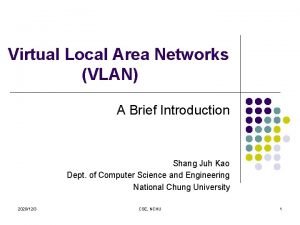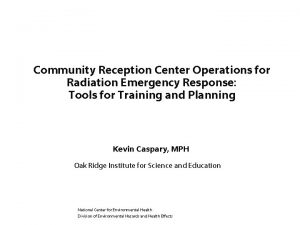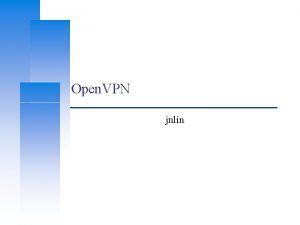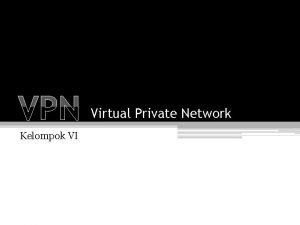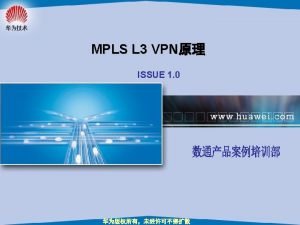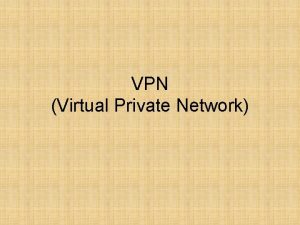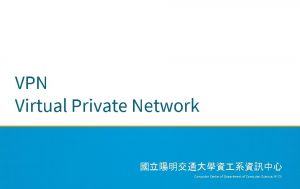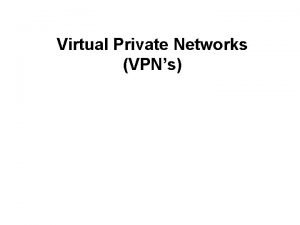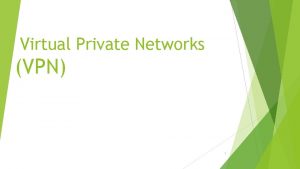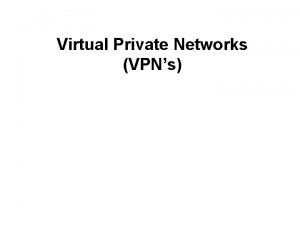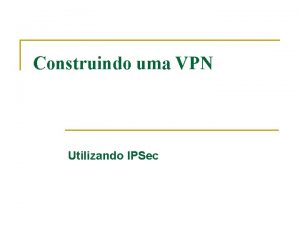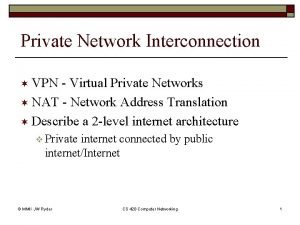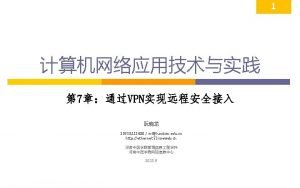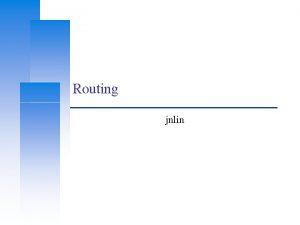VPN Virtual Private Network jnlin Computer Center CS













![Computer Center, CS, NCTU PPP - Point-to-Point Protocol ❑ PPP [RFC 1661] provides a Computer Center, CS, NCTU PPP - Point-to-Point Protocol ❑ PPP [RFC 1661] provides a](https://slidetodoc.com/presentation_image_h2/7a113a34f480d92af718429e4965b9f4/image-14.jpg)

![Computer Center, CS, NCTU 16 PPTP - Point-to-Point Tunneling Protocol ❑ PPTP [RFC 2637] Computer Center, CS, NCTU 16 PPTP - Point-to-Point Tunneling Protocol ❑ PPTP [RFC 2637]](https://slidetodoc.com/presentation_image_h2/7a113a34f480d92af718429e4965b9f4/image-16.jpg)



![Computer Center, CS, NCTU IPsec ❑ IPsec [RFC 4301] is a secure network protocol Computer Center, CS, NCTU IPsec ❑ IPsec [RFC 4301] is a secure network protocol](https://slidetodoc.com/presentation_image_h2/7a113a34f480d92af718429e4965b9f4/image-20.jpg)



- Slides: 23

VPN Virtual Private Network jnlin

Computer Center, CS, NCTU 2 Introduction ❑ Uses public telecommunication channels, such as the Internet or other network service, instead of leased lines channels. ❑ Described as Virtual because it is distant connection using private connections. ❑ Used to widely now because of today's globalization. ❑ Connects users or branches. ❑ Used to use dial-up or Leased communication, now using IP-VPN’s

Computer Center, CS, NCTU 3 What is VPN ❑ Extension of a private network that encompasses links across shared or public networks like the Internet. ❑ Enable to send data between two computers across a shared or public internetwork in a manner that emulates the properties of a point-to-point private link.

Computer Center, CS, NCTU 4 Common Uses of VPNs (1/3) 1. Remote Access Over the Internet Source

Computer Center, CS, NCTU 5 Common Uses of VPNs (2/3) 2. Connecting Networks Over the Internet (Site to Site VPN) Source

Computer Center, CS, NCTU 6 Common Uses of VPNs (3/3) 3. Connecting Computers over an Intranet (similar to 1. ) Source

Computer Center, CS, NCTU Why Use VPN? ❑ Cheap • Legacy private network uses remote connectivity through dial-up modems or through leased line connections, it’s expensive. ❑ Scalable • Extending a leased line connection is complex. • Easy to administer. ❑ Security • 7 Provide encryption and file integrity.

Computer Center, CS, NCTU 8 VPN Key Concept - Tunneling ❑ VPN consists of a set of point to point connections tunneled over the Internet. ❑ In order to achieve tunneling, the packets are encapsulated as the payload of packets. • • Payloads, to and from addresses, port numbers and other standard protocol packet headers As seen by the external routers carrying the connection

Computer Center, CS, NCTU 9 Basic VPN Requirements ❑ ❑ User Authentication Key Management Address Management Data Encryption

Computer Center, CS, NCTU Basic VPN Requirements (1/2) ❑ User Authentication • • • ❑ Key Management • • 10 Verify the VPN client's identity and restrict VPN access to authorized users only. Provide audit and accounting records to show who accessed what information and when. X. 509, pre-shared key, etc. Generate and refresh encryption keys for the client and the server. Simple Key Management for IP: ISAKMP/Oakley, etc.

Computer Center, CS, NCTU 11 Basic VPN Requirements (2/2) ❑ Address Management • Assign a VPN client's address on the intranet and ensure that private addresses are kept private ❑ Data Encryption • • No one outside the VPN can alter the VPN. Data carried on the public network must be rendered unreadable to unauthorized clients on the network.

Computer Center, CS, NCTU VPN Security ❑ Authentication • ❑ Access Control • Restricting unauthorized users from gaining admission to the network. ❑ Confidentiality • Preventing anyone from reading or copying data as it travels across the Internet. ❑ Data Integrity • 12 Ensuring that the data originates at the source that it claims. Ensuring that no one tampers with data as it travels across the Internet.

Computer Center, CS, NCTU Common Implementations ❑ Based on PPP • • ❑ Based on TCP/IP • L 2 TP/IPsec Tunnel mode [RFC 4301] BGP/MPLS IP VPN [RFC 4364] • • ❑ SSL/TLS • • • 13 Point-to-Point Tunneling Protocol (PPTP) (PPP + encryption + GRE) Layer Two Tunneling Protocol (L 2 TP) (PPTP + L 2 F) Secure Socket Tunneling Protocol (SSTP) (PPTP + SSL) SSL VPN Open. VPN
![Computer Center CS NCTU PPP PointtoPoint Protocol PPP RFC 1661 provides a Computer Center, CS, NCTU PPP - Point-to-Point Protocol ❑ PPP [RFC 1661] provides a](https://slidetodoc.com/presentation_image_h2/7a113a34f480d92af718429e4965b9f4/image-14.jpg)
Computer Center, CS, NCTU PPP - Point-to-Point Protocol ❑ PPP [RFC 1661] provides a standard method for transporting multiprotocol datagrams over point-to-point (direct) links. => Data link layer (layer 2) protocol ❑ Three components • • • ❑ Extra Options • • • 14 Encapsulation (for transporting purpose) Link Control Protocol (for data-link connectability) Network Control Protocols (NCP) family (L 3 management support) Authentication: PAP, CHAP, EAP, MS-CHAPv 2, etc. Link Quality and error detection Compression Encryption: MPPC + MPPE, etc. Multilink (MP, The PPP Multilink Protocol)

Computer Center, CS, NCTU Tunneling Protocol Allows a network user to access or provide a network service that the underlying network does not support or provide directly. (Wikipedia) ❑ GRE (Generic Routing Encapsulation): Establish a virtual point-to-point connection between two networks. • • • ❑ ❑ 15 IP as a delivery protocol Virtual Tunnel: (Tunnel) IP header + GRE packet header Encapsulation, not encryption PPTP / L 2 TP IPsec Open. VPN (with SSL/TLS) etc.
![Computer Center CS NCTU 16 PPTP PointtoPoint Tunneling Protocol PPTP RFC 2637 Computer Center, CS, NCTU 16 PPTP - Point-to-Point Tunneling Protocol ❑ PPTP [RFC 2637]](https://slidetodoc.com/presentation_image_h2/7a113a34f480d92af718429e4965b9f4/image-16.jpg)
Computer Center, CS, NCTU 16 PPTP - Point-to-Point Tunneling Protocol ❑ PPTP [RFC 2637] uses an enhanced GRE mechanism to provide a flowand congestion-controlled (TCP) encapsulated datagram service for carrying PPP packets. ❑ PPTP creates a GRE tunnel through which the PPTP GRE packets are sent. Source

Computer Center, CS, NCTU 17 Security of PPTP ❑ PPTP has been the subject of many security analyses and ❑ serious security vulnerabilities have been found • • MS-CHAP is fundamentally insecure. MS-CHAPv 2 is vulnerable to dictionary attack on the captured challenge response packets. ❑ The PPP payload can be encrypted by using Microsoft Point to Point Encryption (MPPE) when using MS-CHAPv 1/v 2 ❑ EAP-TLS (Extensible Authentication Protocol – TLS) is the superior authentication choice for PPTP.

Computer Center, CS, NCTU 18 L 2 TP - Layer Two Tunneling Protocol ❑ L 2 TP [RFC 2661]: PPTP + L 2 F (Layer Two Forwarding) ❑ High level protocols (e. g. , PPP) establish L 2 TP session (“call”) within the L 2 TP tunnel, and traffic for each session is isolated. ❑ A tunnel can contains multiple connections at once. ❑ L 2 TP over IP internetworks uses UDP and a series of L 2 TP messages for tunnel maintenance. ❑ L 2 TPv 3 provides additional security features, improved encapsulation, and the ability to carry data links other than simply PPP over an IP network. (Wikipedia) Source

Computer Center, CS, NCTU 19 L 2 TP/IPsec ❑ L 2 TP does not provide confidentiality or strong authentication. ❑ Usually use IPsec ESP (Encapsulating Security Payload) to encrypt the L 2 TP packet. • • Source Data encryption begins before the PPP connection process by negotiating an IPSec security association. Require computer-level authentication using computer certificates.
![Computer Center CS NCTU IPsec IPsec RFC 4301 is a secure network protocol Computer Center, CS, NCTU IPsec ❑ IPsec [RFC 4301] is a secure network protocol](https://slidetodoc.com/presentation_image_h2/7a113a34f480d92af718429e4965b9f4/image-20.jpg)
Computer Center, CS, NCTU IPsec ❑ IPsec [RFC 4301] is a secure network protocol suite provides authentication and encryption ability over IPv 4 network. ❑ Two modes in IPsec • • Transport mode: Insert IPsec header (AH/ESP) between IP and TCP header, then modify original IP header. Tunnel mode: Encapsulate original packet, and prepend new IP and IPsec header. ❑ Two functions that ensure confidentiality: • • Authentication Header (AH) ➢ Provide source authentication and integrity without encryption. Encapsulating Security Payload (ESP) ➢ Provide both data authentication, data integrity and data encryption. ❑ Security Associations (SA) provides the parameters necessary for AH and/or ESP operations. • 20 IKE (Internet Key Exchange): Provide authentication and key exchange. e. g. , ISAKMP, OAKLEY

Computer Center, CS, NCTU Source 21 IPsec Modes

Computer Center, CS, NCTU SSL VPN ❑ A form of VPN that can be used with a standard Web browser. ❑ Also can be used to tunnel traffic via SSL or TLS protocol ❑ The traffic is encrypted with the SSL protocol or Transport Layer Security (TLS) protocol. ❑ Proprietary software • • • Cisco Any. Connect Juniper Networks Pulse Secure Fortigate ❑ Open Source • 22 Open. VPN

Computer Center, CS, NCTU 23 Appendix ❑ I Am Anonymous When I Use a VPN – 10 Myths Debunked ❑ Virtual Private Networking: An Overview ❑ Beyond. Corp by Google: Protected connection from untrusted networks without the use of a VPN. • See also: Role-Based Access Control (RBAC) ❑ Protocol reference • • VPN PPP / GRE / PPTP / L 2 TP IPsec / IKE IP protocol numbers
 Jnlin
Jnlin Vpn protocols wiki
Vpn protocols wiki Virtual private network
Virtual private network Ipsec vpn vs ssl vpn
Ipsec vpn vs ssl vpn Spispy
Spispy Difference between virtual and datagram circuit
Difference between virtual and datagram circuit What is topology in computer
What is topology in computer Apa itu shared hosting
Apa itu shared hosting Has virtual functions and accessible non-virtual destructor
Has virtual functions and accessible non-virtual destructor Private industrial network
Private industrial network Managed private network
Managed private network Build private cloud with hyper v
Build private cloud with hyper v Netography
Netography Specialized cloud architecture
Specialized cloud architecture Vlan (virtual local area network)
Vlan (virtual local area network) Virtual local area network
Virtual local area network Virtual network management
Virtual network management Community reception center
Community reception center System center - virtual machine manager
System center - virtual machine manager Dna center appliance
Dna center appliance Computer architecture virtual lab
Computer architecture virtual lab Explain virtual memory in computer architecture
Explain virtual memory in computer architecture What do ecologists study
What do ecologists study Features of peer to peer network and client server network
Features of peer to peer network and client server network
